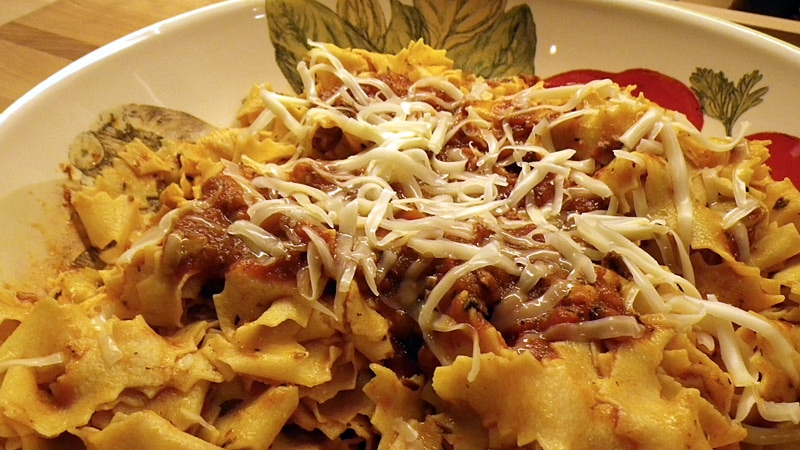|
4/7/2015 Nearly every Sunday of my early childhood my Mom made something most Italian-Americans (especially those from Naples) called Sunday Gravy. Simply put, Sunday Gravy is essentially a large batch of tomato sauce with various types of meat slow cooked into it. In Italian, the word salsa means sauce... a sauce is made from something other than meat. Like putting a fruit or cheese sauce over meat, chicken or fish. The Italian word sugo means gravy. A gravy is made from the liquids and fat that are rendered from various meats--like using turkey drippings to make a gravy. The all-day cooking of meat in tomato sauce gives off a heady scent, that would fill our apartment, and waft out into the hallway for the entire building to smell--"Ahh... the Finzis are making Gravy today!" The secret of Sugo is in its slow cooking, or pippiare (literally, to bubble) technique. Sunday Gravy has it's origins from a beef stew popular in medieval XII-XIV century, way before tomatoes were introduced from the New World--a clay cooker slow cooked the stew of beef and vegetables for hours and hours. This beef stew turned into a ragù, at first created in northern Italy, with the southern Neapolitans evolving the dish further by the eighteenth century. It began as a a dish for nobility, using more expensive cuts of meat, such as beef and veal, but no tomato. (Tomatoes didn't gain popularity right away in Europe... they were thought to be poisonous). This dish was mainly prepared on Sundays, the sauce placed on top of the pasta, with larger cuts of meat served as a second course. One historian described a Sugo using tomatoes in 1857 that was being served in taverns in Naples. You can think of Sunday Gravy is a hybrid of sorts... it starts out as a tomato sauce and becomes a gravy after meats have been added and have rendered their flavors during a long cooking period--the Sunday Gravy of my childhood.  Some of the meat ready to be added to the Gravy Some of the meat ready to be added to the Gravy But Sunday Gravy wasn't just about a making a single meal in la nostra casa. It was an event--a gathering. Making Sunday Gravy is reminiscent of an entire village doing their weekly communal cooking... coming together to make pasta, make bread, make the olive oil, tend the olive trees, fix a roof, gossip, laugh and be together. In Italian communities, ovens were often communal, but ingredients were also communal in many respects--Giuseppe just slaughtered a large pig and barters off some of the meat with Mario, the baker for bread, or perhaps his cousin Maria still has some tomatoes hanging that she would swap, and Marcello's owes him some olive oil to offset the wine that was traded last spring for some pasta. Food was communal. Food was family. And good food takes time and preparation and lasts for more than a single meal... My Mom started making Sunday Gravy sometimes on Saturday... or even in the middle of the week before. Being a working Mom and was frugal with her time. She would make a meat dish one night--maybe the meatballs. Then she'd give us a simple dinner with some of them, but hold most of them for adding to the Sunday Gravy pot. Maybe on Saturday after shopping, she'd make the brasciole and brown the pork ribs under the broiler. These would also go into the fridge, ready for the Sunday Gravy pot. Sunday morning would arrive and I'd go to Mass with one of my sisters and then stop at a bakery to pick up "buns" for our whole family--even my Aunt Rose's family who lived upstairs. In our family's jargon, "Buns" were anything sweet from the bakery... cream donuts dusted with cinnamon, raisin "buns" (my favorite), a crumb cake with crumbs as big as my 5 year old fist, a cheese danish that would fill a plate, and maybe a dozen "mixed buns"... assorted goodies that the person behind the counter would surprise us with
Sunday Gravy wasn't just about the one meal. It was also about what we'd be eating in the coming week--there would be lots of leftovers in that big pot. The gravy might even allow us to cheat a little on "meatless Friday" by using just the tomato sauce without any meat on pasta, ravioli or with fish. And everyone knows that Gravy tastes even better over the next few days. The flavors of all those meats meld into the sauce turning it magically into a true gravy--rendered from meat. It's a carnivore's manna--nectar straight from our Roman and Greek bloodlines. My Dad's very large family ate from a single pot.... and a single bowl in the middle of the table. You can imagine the Sunday Gravy there with brothers and sisters taking a meatball here, a rib there... a couple of these meats, a piece of bread or pasta and some of this gravy and you had an incredible meal. Filling, nutritious and delicious. A necessary thing when our Nonna's had so many mouths to feed with so little.  Mariantonia Delulia, my Grandma Mariantonia Delulia, my Grandma In our famiglia, there were lots of mouths to feed--seven of us in our family, and the dog. My cousins and Aunt would stop by, too. Then there were my sisters' girl friends and my brother's crew. There were always extra plates for whoever stopped by. It was about the famiglia... the heritage... the food... the tastes that even our memories had forgotten and unknowingly were our a link to our past.... Naples, Molfetta... and my maternal Grandmother, Mariantonia Delulia. (Once I learned her real name I was compelled to say her full name over and over... like poetry off an Italian tongue... "Maree - ahn-TONE-eaa-ahh Day-LULE-eeah". ) This wonderful lady towered over me (as a small child) at 4' 10", with her greyed hair tucked into a bun in the daytime, but releasing nearly three feet of it down her back at night before bed. Grandma made her own version of Gravy... everyone does it slightly differently. She'd add large strips of peppers and larger chunks of onions, and put pignoli in her meatballs. A cut up pork shoulder (the affordable cut for poor immigrants, when they could afford it) was key to her recipe, along with hot sausage (way too spicy for my young tongue back then). Before we would get through the comics, our little railroad apartment would start to smell differently.... sweet, pungent... Italian. Mom would start by taking a huge onion and cutting it up into small pieces... and sautéing them in the bottom of her huge stock pot on the kitchen stove until they were soft and glistening and letting off their pungent scent. Then she would add the diced carrots, celery and garlic. After that, my Dad would get the wine from the cellar (he'd sometimes have jugs of some home made wine he got from my Uncle down there) and pour some into the pot. Not sure how much.... maybe a couple of cups. Next, Mom would let one of us open the cans--big cans of imported tomato puree. It was fun opening cans using the wall-hung can opener over by the dumb waiter door (nailed shut by Dad so us kids wouldn't try to go for a ride.) About four or five cans would go into the pot. Next came the spices. A handful of sugar to cut the acidity, half-handful each of dried basil, oregano, thyme, garlic powder (or a 5-6 cloves of fresh when Mom had it), a good sprinkle of red pepper flakes, a tablespoon each of salt and pepper, then a quarter cup of olive oil. If Mom had any leftover rinds of cheese from a grating wedge, they'd go in too. Then she'd take out the meat... lots of it. A rack of ribs cut up would be layered in like logs at the bottom of a red lake. Then would come the sausage browned and cut up into 2 inch pieces, then add the brasciole--all tied up like meaty little packages, and then the meatballs. Then the Sunday Gravy pot is put on the back burner--the smallest one--and starts to simmer and simmer, bubbling like a crater of lava from the old world. The aromas get more and more intense as the day goes on--you can taste the flavors turning the tomato sauce into something... luscious. My siblings' friends come and go with an open door policy, my mother always inviting them to have a "bun" or sit down for a meatball sandwich. There was more than enough... a few would never be missed. As for us, we would taste the Gravy all day long by getting a piece of bread and spooning some on top. What a treat. I still do this when I make gravy--or sauce. Taste it on top of a piece of bread... fine tune the spices, then simmer some more. Lucas is growing to love this little snack way before dinnertime. In the Fifties we would sometimes eat Sunday "dinner" at 2 in the afternoon if my Mom was lucky enough to get the Sunday Gravy in the pot early enough. Otherwise, we'd eat by 5 or so. There was no set dinner time on Sundays in our house. Besides, we had "buns" in our bellies--the starch, fat and sugars keeping our fluttering young hearts going. No one went hungry on Sundays.  Shaping meatballs Shaping meatballs The New Famiglia Finzi "Gravy" This past Easter I made Sunday Gravy, as I described above. I didn't follow a recipe... I followed my memories. Perhaps this is why I didn't write this article as I would a normal recipe. I don't want people to simple follow the recipe in any strict way. This a recipe that needs to be felt. Vary it with love--the things you love, and share it with people you love. Make meals out of its components both before, during--and after--making it. We've already had two meals from it. It all came together for Easter Sunday's late afternoon meal, as my family had done time and time again so many years ago. We'll probably freeze half of it for future meals. We made home made tagliatelle to have with it the first night and a risotto for another meal on another day. But we also had each other. We shared garlic bread and wine with it--Lucas had a little glass too. I'm teaching Lucas how to drink with a meal rather than drink to get drunk. He places a small forkful of meat in his mouth, chews a bit, sips some wine and discovers the flavors as they mingle and merge into something Godlike.  Making the tagliatelle Making the tagliatelle Making Sunday Gravy was like having a family Mass with a prayer beforehand, and more afterwards. It's a joy to watch my boy Lucas' eyes light up as he discovers great flavors. Lisa helped me with some parts of the meat preparations as early as Thursday. Lucas helped make the meatballs and the pasta. Lucas is also a spice expert (great palette on that kid), so I told him to, "Make an Italian tasting spice rub for the ribs". He nailed it. Mom made the risotto we had for our second meal (her first time making risotto... usually I do all the stirring). The Gravy mixing with the rice turning it into something dreamy. Traditions--or perhaps I should say rituals-- are important in our family, and in our food. After all, the food holds ties to our heritage and the food eventually becomes us. Literally and spiritually.
Happy Easter. And thanks, Mom for all those tasteful Sundays. --Jerry Finzi |
Archives
May 2024
Categories
All
|











